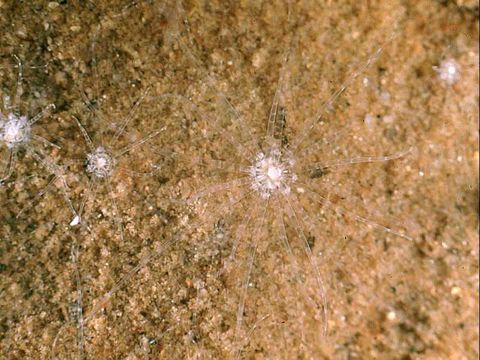Aquatic scientific names in the news …
A small sea anemone, Nematostella vectensis, has recently featured in a number of news stories regarding the future possibility of regenerating human heart tissue.
In a study published in the journal Proceedings of the National Academy of Sciences, scientists from the University of Florida have found genes known to help form hearts cells in humans in the gut of Nematostella vectensis. Interestingly, this anemone has the capacity to regenerate and, if cut into pieces, each piece has the capacity to grow into a new animal.
 Image: Whitney Lab for Marine Bioscience
Image: Whitney Lab for Marine Bioscience
The scientists believe that if they can learn how these genes give rise to heart cells that they may be able to figure out how to improve muscle regeneration in humans. Once genes are turned on in humans to create, for example, heart cells they cannot become any other type of cell, they can only be heart cells. In the anemone this fixation does not occur leaving cells free to become other types of cells or to fulfil other functions.
Cell regeneration in the human heart is limited to a slow replacement of damaged cells resulting in a build-up of scar tissue.
With further study its hoped to find ways of improving communication between human genes, mimicking the anemone’s capacity to regenerate, and advance our ability to treat heart conditions through regenerative healing.
 Image: National Museums Northern Ireland
Image: National Museums Northern Ireland
Nematostella vectensis is a small sea anemone with a bulbous basal end and a contractile column ranging in length from around 2 to 6cm. Usually found buried up to the crown in fine silt or sand, with its tentacles flared out on the surface of the sediment. When not feeding the tentacles retract into the column
At the top of the column is an oral disk containing the mouth surrounded by two rings of long slender tentacles numbering between fourteen and twenty, the outermost being longer than the inner ones. It is translucent and largely colourless but usually has a pattern of white markings on the column and white banding on the tentacles.
It is found on the eastern and westward seaboard of North America with a range extending from Nova Scotia to Louisiana on the east coast and from Washington to California on the west coast. It is also known from three locations in the United Kingdom, two in East Anglia and one on the Isle of Wight. Typically found in shallow water in brackish ponds and lagoons, and in ditches and pools in salt marshes.
Nematostella vectensis is used as a model organism in a number of fields including developmental biology, ecology, the study of evolution, reproductive biology. and has a dedicated genomics database. It is easy to care for in captivity and reproduces readily in the laboratory.
Nematostella vectensis Stephenson, 1935 – Starlet sea anemone
Etymology
Nematostella – Greek, Nemato-, nematos (νηματος), that which is spun, thread, filament; Latin, -stella, star. Likely alluding to the thread-like form of the tentacles and the star-like markings surrounding the oral disc.
vectensis – Latin, of, or coming, from the Isle of Wight; vectis, an island south of Britain (classical – Pliny). The type locality for the species is at Bembridge, on the Isle of Wight.